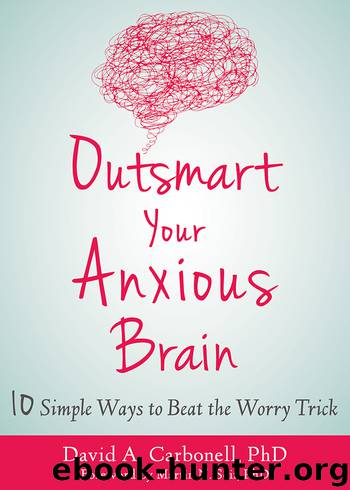Outsmart Your Anxious Brain by David A. Carbonell

Author:David A. Carbonell
Language: eng
Format: epub
Publisher: New Harbinger Publications
Published: 2019-12-11T20:59:08+00:00
The Two-Part Test
When you think there might be a useful signal in your worry content, use this two-part question to evaluate it.
Does the problem I’m worrying about exist in the world around me now, the world outside of my mind and imagination?
If it does, is there anything I can do to change it now?
If you get two yes answers to these questions, then maybe worry isn’t your main problem. The two yes answers would indicate that you have a worry about an actual problem that exists now, outside of your mind, a problem you can do something about. That’s what ordinary worry is for, to remind you to take action when you can, and that’s probably what you need to do.
People who find evidence of a problem in the world around them—their son is having trouble getting into college, an aged parent is likely to die in the near future, or their job is at risk—will be better served by taking action to avoid or prepare for that problem than they would be struggling with the worry. If the worry persists after they have taken whatever actions are available to them and there’s no longer any useful information being conveyed by the thought, then they could simply notice the thought and respond in the manner described in this chapter and the next.
But if you get any other combination of answers—a no to the first question, a yes and a no, or answers like what if, couldn’t it happen, imagine that, I suppose—then you don’t have a problem you’re worrying about; you have the problem of worrying.
If Chris were to apply this test to his worries about his upcoming job evaluation, he would likely get a no to the first question. There doesn’t appear to be anything going on in the world around him that is problematic. The only sign of “trouble” is the nervous thoughts that he experiences within his own mind. And since there isn’t a problem in the world around him, there is nothing “out there” he can change.
If that’s what you have—worrisome thought symptoms, rather than an actual problem in the external world that you need to solve—then it will be helpful to accept and humor those thoughts, rather than get tricked into taking the content seriously.
If you have an actual problem out there in the world around you and you’ve already done whatever you can do about it, well then, there’s no longer any useful signal in your worry thought, and you can treat it the same way. That thought is like a duplicate copy of an e-mail that you already responded to. It no longer has any important information you can use.
Download
This site does not store any files on its server. We only index and link to content provided by other sites. Please contact the content providers to delete copyright contents if any and email us, we'll remove relevant links or contents immediately.
| Adult Children of Alcoholics | Alcoholism |
| Drug Dependency | Gambling |
| Hoarding | Obsessive Compulsive Disorder (OCD) |
| Sexual | Smoking |
| Substance Abuse | Twelve-Step Programs |
The Hacking of the American Mind by Robert H. Lustig(4338)
Right Here, Right Now by Georgia Beers(4167)
Fingerprints of the Gods by Graham Hancock(3964)
Goodbye Paradise(3761)
Bad Pharma by Ben Goldacre(3396)
Happiness by Matthieu Ricard(3020)
More Language of Letting Go: 366 New Daily Meditations by Melody Beattie(3001)
The Social Psychology of Inequality by Unknown(2987)
The Plant Paradox by Dr. Steven R. Gundry M.D(2581)
Drugs Unlimited by Mike Power(2564)
Confessions of a Shopaholic by Sophie Kinsella(2309)
Borders by unknow(2280)
Make Love Not Porn by Cindy Gallop(2080)
Dry by Augusten Burroughs(2072)
Stop Being Mean to Yourself: A Story About Finding the True Meaning of Self-Love by Melody Beattie(1964)
Getting Off by Erica Garza(1910)
Belonging by Unknown(1836)
Yoga and the Twelve-Step Path by Kyczy Hawk(1806)
Unmasking Male Depression by Archibald D. Hart(1783)
